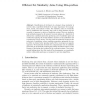Free Online Productivity Tools
i2Speak
i2Symbol
i2OCR
iTex2Img
iWeb2Print
iWeb2Shot
i2Type
iPdf2Split
iPdf2Merge
i2Bopomofo
i2Arabic
i2Style
i2Image
i2PDF
iLatex2Rtf
Sci2ools
ADBIS
2009
Springer
2009
Springer
Efficient Set Similarity Joins Using Min-prefixes
Identification of all objects in a dataset whose similarity is not less than a specified threshold is of major importance for management, search, and analysis of data. Set similarity joins are commonly used to implement this operation; they scale to large datasets and are versatile to represent a variety of similarity notions. Most set similarity join methods proposed so far present two main phases at a high level of ion: candidate generation producing a set of candidate pairs and verification applying the actual similarity measure to the candidates and returning the correct answer. Previous work has primarily focused on the reduction of candidates, where candidate generation presented the major effort to obtain better pruning results. Here, we propose an opposite approach. We drastically decrease the computational cost of candidate generation by dynamically reducing the number of indexed objects at the expense of increasing the workload of the verification phase. Our experimental find...
| Added | 12 Aug 2010 |
| Updated | 12 Aug 2010 |
| Type | Conference |
| Year | 2009 |
| Where | ADBIS |
| Authors | Leonardo Ribeiro, Theo Härder |
Comments (0)

